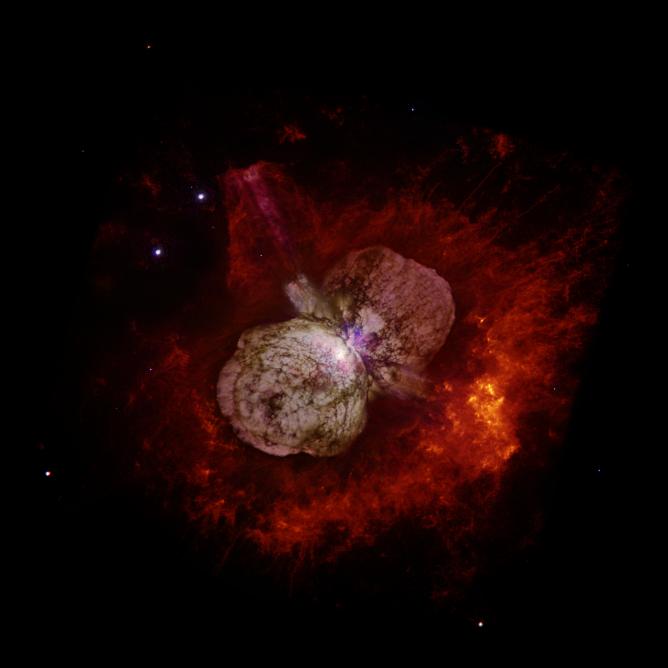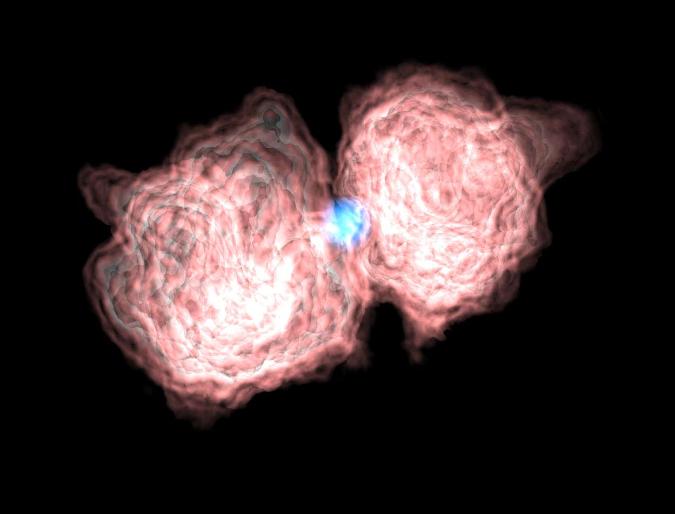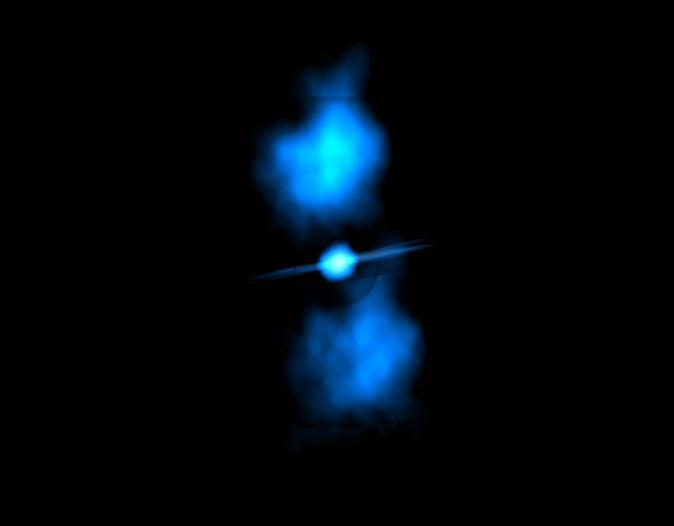| Blue
Hypergiants, OF Stars and Wolf-Rayets |
actually an astronomy classification for stars based on their mass. Blue hypergiants are very massive
and very luminous hot blue giant stars that are on the Main Sequence, but are very near the maximum
mass limit for a star. They are of spectral class O. They have between 80 and 200 times the mass of the
Sun - to start with. They don't keep all this excess mass for long, but rapidly lose mass in an expanding
shell of hot gas, which may be seen expanding as two lobes, one from each stellar pole, or as a spherical
nebula. Material may also be jetted off from the star's equator. This mass loss is driven by an intense
stellar wind which is ten billion or more times as powerful as the Sun's solar wind. These stars are very
rare, only a few dozen occur within the Milky Way Galaxy (a galaxy of some one hundred billion stars).
The star above is about 130 times the mass of the Sun (130 solar masses), and about 5 million times as
luminous!
The brink of stability - the Eddington limit
Like a hoarder who decides to sell it all from their pods storage unit, these starts accumulated so much
mass during their formation from their parent nebula, that when nuclear fusion really gets going, the rate of
these nuclear processes is so high that the star generates a tremendous amount of light. These stars may
have luminosities over ten million times that of the Sun! Many of the photons (particles of light) produced
slam into the atmosphere of the star, as they journey outwards from the core, and impart so much energy
to the plasma that they blast off tremendous amounts of material from the star's atmosphere into space.
This tremendous force generated by sheer light (and other forms of radiation) power is called the
radiation pressure. A star with a mass of about 120 solar masses is close to the Eddington limit - the
Eddington limit occurs when the radiation pressure that is pushing the star's atmosphere outwards, exactly
balances the immense force of gravity which is trying to pull the atmosphere in towards the core. This is a
very precarious state of affairs - the balance is so fine that the star becomes unstable.
This mass loss is unstable and varies over time. Eta Carinae is a blue hypergiant with bi-lobed (and some
equatorial) outflow, similar to the star above, and situated some 7000 to 8000 light years from Earth. In
1730 and 1843 Eta Carinae reached peak brightness (after brightening over some 23 years) about a
tenfold increase in brightness, to become the second brightest star in the Earth's sky in 1843. These
pseudosupernova events resemble a supernova, but the star survives, it simply blasts off a vast amount
of material as the radiation pressure builds up inside, rather like a pressure boiler venting off steam. The
ejected material may expand outwards at speeds of around 3000 kilometres per second! Other examples
of these stars include the Pistol Star and LBV 1806-20.
The short life of a hypergiant
More massive stars may have more fuel to burn, but they burn it disproportionately fast and so have much
shorter lifespans than smaller stars. For example, the Sun has a lifespan of some ten billion years, but
blue hypergiants live for around one to three million years - very short in stellar terms. These stars begin
life as young hot blue giant Of stars, but no sooner have they finished accreting mass when they begin to
lose it. The fate of a blue hypergiant really depends on how quickly it loses mass and so how quickly it
reaches a more stable mass of around 10-30 solar masses. Those that live in isolation have only their
radiation pressure to relieve themselves of their burden, but those in binary systems may find their
companion star sucking away their tenuous and loosely bound outer atmosphere and so may lose mass
much more rapidly.
Eventually (after about one million years) it is thought that blue hypergiants become Wolf-Rayet stars.
Wolf-Rayet stars are intermediate mass stars of about ten solar masses with very little hydrogen but with
helium or oxygen atmospheres instead. Supergiant stars produce heavier elements in their cores, with
hydrogen remaining in the outer atmosphere, underneath which is a layer of helium and underneath this a
layer of carbon and oxygen, nitrogen or oxygen. Thus these stars appear to have shed their outer
hydrogen layer, exposing their hot helium and oxygen rich cores. About 50% of Wolf-Rayet stars occur in
known binary systems.
How hypergiants end their lives depends on how much mass they manage to eject during their brief and
precarious youths. If they make it down to 10 solar masses, then they probably end in supernova
explosions. If they end with much more mass then they may end as a hypernova - an extra powerful
explosion that may be a thousand times as powerful as a supernova! Hypernovae emit huge amounts of
highly energetic gamma-rays. Eta Carinae could go any day from now to a million years from now, and
when it does, despite being 7000 light years (over 60 million billion kilometres) away, its gamma-rays could
badly damage the Earth's ozone layer and damage spacecraft, satellites and astronauts who are in space
at the time. You certainly wouldn't want to be much closer!
Example: Eta Carinae

Above:
a photograph of Eta Carinae, a blue hypergiant star. (Photo
credits: NASA/HST: J. Morse (Arizona
State U.), K. Davidson (U. Minnesota) et al., WFPC2, HST, NASA).
Eta Carinae (Tseen She, lit. ‘Heaven’s Altar’, or Foramen) is a
blue hypergiant star and an LBV
(large
blue variable)
star some 7500-8000 light years from Sol situated in the
Homunculus Nebula which was created from matter blasted off from
the star. It is a variable (and probable) binary star and it is
the most massive and most luminous star in the Milky Way Galaxy.
In 1843 Eta Carinae brightened by a factor of at least ten (to
magnitude -0.8), emitting almost as much light as a supernova
and becoming the second brightest star in the sky, but it
survived this eruption (called a pseudo-supernova). At its
observed dimmest, between 1900 and 1940, it became magnitude 8.
At the moment its magnitude is currently below 5 and so it can
be seen with the naked eye. The star underwent an X-ray eclipse
in 2003, most likely due to the dynamics of wind-wind collision
with a companion star. These eclipses follow a 5.52 year cycle.
Eta Carinae is now thought to be a binary system, with the main
larger blue hypergiant star possessing an initial mass of about
120 to 150 solar masses, before blasting off much of its
material to reduce its mass to around 100 solar masses. The
combined mass of the system is about 130 solar masses, with an
optically invisible companion star of about 30 solar masses
hidden by the cloud of material blasted off the primary star.
This lighter companion star may be a Wolf-Rayet star.
Wolf-Rayet stars are very hot and luminous stars with a surface
temperature of about 90 000 K with strong and broad emission
lines of ionised helium, carbon, oxygen and nitrogen. These
ionisation lines probably come from expanding atmospheres,
expanding at 40 to 3000 km/s as the star rapidly loses mass.
Wolf-Rayets are probably the centres of initially much more
massive OF stars.
Above:
Eta Carinae. (Photo credits: NASA/HST: J. Morse (Arizona State
U.), K. Davidson (U. Minnesota) et al., WFPC2, HST, NASA).
Questions
remain: is there an upper mass limit to stars, and if so, then
what is it? How massive can a star be before it is too unstable
to survive even by rapid mass loss? There are only about a dozen
hypergiant stars in a typical large spiral galaxy. VY Canis
Majoris (VY CMa) holds the current record as the largest star known to terrestrial
observers and also one of the most luminous. It is about 2000
times the diameter of the Sun, 4900 light-years from Earth and
is red hypergiant (or perhaps a red supergiant or the supergiant
equivalent of a hypergiant star!)and a solitary star. It is
thought to have been an O star of about 30 - 40 solar masses
before it left the main sequence and is predicted to go
hypernova in about 100 000 years time. It's present spectral
class is M, with a surface temperature of about 3000 K.
The most
massive star known
(to terrestrial observers) is R136a1, another blue hypergiant
,near the Tarantula Nebula in the Large Magellanic Cloud, with
an estimated mass of 265 - 320 solar masses (over the years the
maximum size of stars keeps increasing with new discoveries!).
It stole the title of most luminous star (at one time attributed
to Eta Carinae) with a luminosity some 8.7 million times that of
the Sun! Supermassive stars are hypothetical stars with a mass
in excess of 1000 solar masses - no star has yet claimed this
title!
Credits: NASA , ESA , N. Smith (University of Arizona), and J. Morse (BoldlyGo Institute) 2019.
Above: imaged in the ultra-violet, showing warm magnesium-rich gas (blue) and shock-heated nitrogen (red). https://hubblesite.org/contents/media/images/2019/18/4505-Image?keyword=Nebulas&news=true
Article updated: 8 April 2020
lines in ionised helium ( He(II) or He+) and ionised nitrogen ( N(III) or N++ ) and a clear absorption
spectrum. The emission lines come from atmospheric material which is being lost from the star. OF stars
are blue hypergiants (or more specifically become blue hypergiants when mature) and are thought to
eventually evolve into Wolf-Rayet stars. OF stars are among the most massive in the galaxy. Such stars
tend to exhibit dramatic changes in luminosity, due to their instability and so become LBV (large blue
variable) stars. These stars are of spectral type O and so are a subclass of OB stars (large hot white and
blue stars of spectral types O and B) and so are ultraviolet stars (emitting most of their light as UV).


